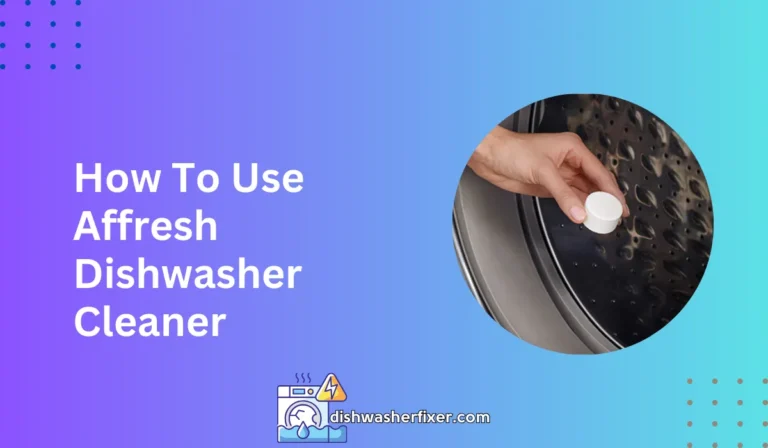How to Remove Mold from Dishwasher: Easy Cleaning Hacks
To remove mold from a dishwasher, first, wear gloves for safety. Empty the dishwasher and clean the filter. Then, run a hot water cycle with 1 cup of white vinegar placed on the top rack. Afterward, sprinkle baking soda on the bottom and run a short, hot water cycle.
Understanding Mold in Your Dishwasher

Why Mold Loves Your Dishwasher
Mold thrives in warm, moist environments, making your dishwasher an ideal breeding ground.
Dishwashers provide mold with the necessary elements it needs to grow, such as organic food particles from dirty dishes and a consistent supply of moisture.
Furthermore, the darkness inside the dishwasher when the door is closed creates a perfect habitat for mold colonies to develop.
The Dangers of Mold
Exposure to mold can be harmful to your health.
It can cause a variety of respiratory issues, allergic reactions, and in severe cases, it can lead to infections, especially in individuals with weakened immune systems.
That’s why it’s crucial to address mold growth promptly and effectively.
Spotting Signs of Mold
Identifying mold in your dishwasher is often as simple as using your senses. Look for black, green, or white spots along the rubber seals, in the filter, or on the racks.
A musty smell is a clear indicator that mold might be present. If you notice any of these signs, it’s time to clean your dishwasher.
Cleaning Mold from Your Dishwasher

Protect Yourself and Your Kitchen
Before tackling mold, ensure your safety by wearing gloves and a mask. Open windows or turn on an exhaust fan to keep the area well-ventilated. Safety is paramount when dealing with mold and cleaning agents.
Empty and Inspect
Start by removing all dishes and utensil holders from your dishwasher. This will give you full access to all areas that need cleaning and allow you to inspect for mold growth thoroughly.
Filter Detox
The filter is often a hotspot for mold because it traps food particles. Remove the filter according to the manufacturer’s instructions, and clean it separately using hot, soapy water. A soft brush can help dislodge any trapped debris.
Choosing Your Mold-Fighting Hero
Vinegar is a natural disinfectant and deodorizer, making it an excellent choice for mold removal.
Alternatively, baking soda is a mild abrasive that can help remove mold stains. Avoid using bleach if your dishwasher has a stainless steel interior or rubber seals, as it can be corrosive.
Run the Cleaning Cycle
Place a cup of white vinegar on the top rack and run the dishwasher on the hottest cycle. This will help to disinfect and loosen any mold or grime.
After the vinegar cycle, sprinkle baking soda on the bottom of the dishwasher and run a short, hot cycle to freshen and further clean the interior.
Getting into the Nooks and Crannies
Use a toothbrush or soft brush to scrub any areas that still show signs of mold. Pay special attention to the rubber seals, spray arms, and hard-to-reach corners where mold can hide.
Final Wipe-Down and Reassembly
After brushing, wipe down all surfaces with a microfiber cloth to remove any remaining mold spores.
Reattach the filter and any other components you removed, ensuring everything is dry before putting your dishwasher back into service.
Preventing Mold Regrowth

Adopt a Cleaning Routine
Clean your dishwasher regularly, at least once a month, to prevent mold from taking hold. After each use, wipe down the interior surfaces and leave the door ajar to allow air circulation.
Scrape, Don’t Rinse
Scrape food scraps off dishes before loading them into the dishwasher. Excessive pre-rinsing is unnecessary and can contribute to mold growth by leaving water behind.
Air It Out
Improve ventilation by cracking the dishwasher door open after each cycle. This allows the interior to dry completely and prevents the stagnant, moist environment mold loves.
Combat Humidity with a Dehumidifier
If you live in a high-humidity area, using a dehumidifier in your kitchen can help reduce the risk of mold growth. This device will help maintain a drier environment, discouraging mold from settling in.
Smart Settings and Products
Use dishwasher detergents that contain mold inhibitors and opt for cycles that include a drying phase. Some dishwashers have specific settings designed to prevent mold and mildew; refer to your owner’s manual to find out if yours does.
FAQs About Removing Mold from Dishwasher
What safety precautions should I take before removing mold from my dishwasher?
Before removing mold from a dishwasher, wear gloves to protect your hands and prevent direct contact with mold.
How do I prepare my dishwasher for a mold removal cleaning cycle?
Empty the dishwasher completely and clean the filter thoroughly before starting the mold removal process.
What is the first step in the actual cleaning process to remove mold?
The first cleaning step is to run a hot water cycle with 1 cup of white vinegar placed on the top rack of the empty dishwasher.
How does baking soda help in the mold removal process?
Baking soda helps by acting as a mild abrasive to scrub away mold residue and by neutralizing any odors after the vinegar cycle.
What should I do after the vinegar cycle to ensure all mold is removed?
After the vinegar cycle, sprinkle baking soda on the bottom of the dishwasher and run a short, hot water cycle to remove any remaining mold and odors.
Final Thoughts
To effectively remove mold from a dishwasher, start by donning gloves for protection. Ensure the dishwasher is empty and the filter is clean.
Run a cycle with hot water and a cup of white vinegar on the top rack to eliminate mold. Follow up with a layer of baking soda at the bottom and execute a short hot water cycle for a thorough cleanse.





